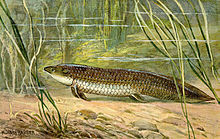Ceratodus
| Ceratodus | |
|---|---|
 | |
| Illustration of Ceratodus by Heinrich Harder | |
| Scientific classification | |
| Domain: | Eukaryota |
| Kingdom: | Animalia |
| Phylum: | Chordata |
| Clade: | Sarcopterygii |
| Class: | Dipnoi |
| Order: | Ceratodontiformes |
| Family: | †Ceratodontidae |
| Genus: | †Ceratodus Agassiz, 1837 |
| Type species | |
| Ceratodus latissimus Agassiz, 1837[1] | |
| Other species | |
| Many more, see text | |
Ceratodus (from Greek: κέρας kéras, 'horn' and Greek: ὀδούς odoús 'tooth')[2] is an extinct genus of lungfish. It has been described as a "catch all",[3] and a "form genus"[4] used to refer to the remains (typically toothplates) of a variety of lungfish belonging to the extinct family Ceratodontidae. Fossil evidence dates back to the Early Triassic.[5] A wide range of fossil species from different time periods have been found around the world in places such as the United States, Argentina, Greenland, England, Germany, Egypt, Madagascar, China, and Australia.[6] Ceratodus is believed to have become extinct sometime around the beginning of the Eocene Epoch.
Species[edit]
- C. latissimus Agassiz, 1837 (type)
- C. eruciferus Cope, 1876 (nomen dubium)[7]
- C. hieroglyphus Cope, 1876 (nomen dubium)
- C. robustus Knight, 1898[8]
- C. africanus Haug, 1905
- C. avus W. H. Ferguson 1906
- C. humei Priem, 1914
- C. elegans Vollrath, 1923[9][10]
- C. frazieri Ostrom, 1970[11]
- C. gustasoni Kirkland, 1987[12]
- C. fossanovum Kirkland, 1998[13]
- C. stewarti Milner and Kirkland, 2006[14]
- C. texanus Parris et al., 2011 [15]
- C. carteri Main et al., 2014[16]
- C. kranzi Frederickson et al., 2016[17]
- C. kirklandi Frederickson & Cifelli, 2016[4]
- C. molossus Frederickson & Cifelli, 2016
- C. kempae Frederickson & Cifelli, 2016
- C. nirumbee Frederickson & Cifelli, 2016
- C. tunuensis Agnolin et al., 2018 [6]
- C. guanganensis Wang et al., 2022[18]
- C. shishkini Minikh, 2023[19]
Gallery[edit]
- Ceratodus tooth plates
- Ceratodus
References[edit]
- ^ Agassiz L., 1837. in Egerton, Catal. Foss. Fish. [n.n.]; (1838), Poiss. Foss., 3, 129.
- ^ Roberts, George (1839). An etymological and explanatory dictionary of the terms and language of geology. London: Longman, Orme, Brown, Green, & Longmans. p. 28. Retrieved 29 December 2021.
- ^ Gottfried, Michael D.; Stevens, Nancy J.; Roberts, Eric M.; O'Connor, Patrick M.; Chami, Remigius (January 2009). "A new Cretaceous lungfish (Dipnoi: Ceratodontidae) from the Rukwa Rift Basin, Tanzania". African Natural History. 5: 31–36. ISSN 2305-7963.
- ^ a b Frederickson, Joseph A.; Cifelli, Richard L. (January 2017). "New Cretaceous lungfishes (Dipnoi, Ceratodontidae) from western North America". Journal of Paleontology. 91 (1): 146–161. Bibcode:2017JPal...91..146F. doi:10.1017/jpa.2016.131. ISSN 0022-3360. S2CID 131962612.
- ^ Romano, Carlo; Koot, Martha B.; Kogan, Ilja; Brayard, Arnaud; Minikh, Alla V.; Brinkmann, Winand; Bucher, Hugo; Kriwet, Jürgen (February 2016). "Permian-Triassic Osteichthyes (bony fishes): diversity dynamics and body size evolution". Biological Reviews. 91 (1): 106–147. doi:10.1111/brv.12161. PMID 25431138. S2CID 5332637.
- ^ a b Agnolin, F. L., Mateus O., Milàn J., Marzola M., Wings O., Adolfssen J. S., & Clemmensen L. B. (2018). Ceratodus tunuensis, sp. nov., a new lungfish (Sarcopterygii, Dipnoi) from the Upper Triassic of central East Greenland. Journal of Vertebrate Paleontology. e1439834
- ^ Cope E.D. (1876) Descriptions of some vertebrate remains from the Fort Union beds of Montana. Proceedings of the Academy of Natural Sciences of Philadelphia, v. 1876, p. 248–261.
- ^ Knight W.C. (1898) Some new Jurassic vertebrates from Wyoming: American. Journal of Science, ser. 4, v. 5, p. 186.
- ^ Ceratodus elegans n. sp. aus dem Stubensandstein. P Vollrath, Jahresberichte und Mitteilungen des Oberrheinischen …, 1923
- ^ elegans Vollrath 1923 (lungfish) "PaleoDB taxon number: 321084-titile=†Ceratodus elegans Vollrath 1923 (lungfish)". Fossilworks. Gateway to the Paleobiology Database.
{{cite web}}: Check|url=value (help) - ^ Ostrom J.H. (1970) Stratigraphy and paleontology of the Cloverly Formation (Lower Cretaceous) of the Bighorn Basin area, Montana and Wyoming: Peabody Museum of Natural History Bulletin, v. 35, 234 p.
- ^ Kirkland J.I. (1987) Upper Jurassic and Cretaceous lungfish tooth plates from the Western Interior, the last dipnoan faunas of North America. Hunteria, v. 2, p. 1–16.
- ^ Kirkland J.I. (1998) Morrison fishes. Modern Geology, v. 22, p. 503–533.
- ^ Milner A.C., and Kirkland J.I. (2006). Preliminary review of the Early Jurassic (Hettangian) freshwater Lake Dixie fish fauna in the Whitmore Point Member, Moenave Formation in southwestern Utah. New Mexico Museum of Natural History and Science Bulletin, v. 37, p. 510–521.
- ^ Parris D.C., Grandstaff B.S., and Banks N.T. (2011). Lungfishes from the Trinity Group (Cretaceous) of North Texas. Texas Journal of Science, 63.
- ^ Main D.J., Parris D.C., Grandstaff B.S., and Carter B. (2014). A new lungfish (Dipnoi: Ceratodontidae) from the Cretaceous Woodbine Formation, Arlington Archosaur Site, north Texas. Texas Journal of Science, v. 63, p. 283–298.
- ^ Frederickson J.A., Lipka T. R., and Cifelli R.L. (2016). A new species of the lungfish Ceratodus (Dipnoi) from the Early Cretaceous of the eastern U.S.A. Journal of Vertebrate Paleontology. Online edition: e1136316. doi:10.1080/02724634.2016.1136316.
- ^ Wang, Z.; Jiang, X.; Wang, X.; Gao, J.; Zhu, S. (2022). "Tooth Plates of Ceratodus (Dipnoi, Ceratodontidae) from the Upper Jurassic Shaximiao Formation of Guang'an, Sichuan Province, China". Acta Geologica Sinica (English Edition). 96 (3): 766–775. doi:10.1111/1755-6724.14774. S2CID 237853795.
- ^ Minikh, A. O. (2022). "A New Species of the Genus Ceratodus (Dipnoi, Ceratodontidae) from the Triassic of the Southern Cis-Urals". Paleontological Journal. 56 (11): 1385–1390. doi:10.1134/S0031030122110090. S2CID 256618440.
- Ceratodus at The Paleobiology Database


 French
French Deutsch
Deutsch


